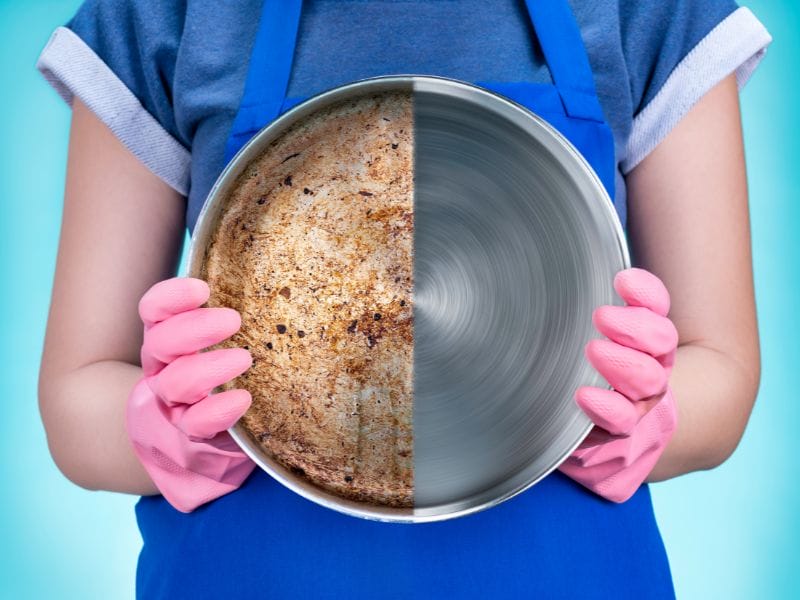
Cleaning pots and pans may not be the most glamorous task in the kitchen, but it’s an essential one if you want your cookware to last and your food to taste its best. In this comprehensive guide, we’ll take you through the steps to clean various types of pots and pans, from stainless steel to cast iron and share expert tips and tricks along the way. Say goodbye to stubborn stains and burnt-on residue as we dive into the world of effective pot and pan cleaning.
Gathering Your Supplies
Before diving into the cleaning process, it’s crucial to have all your supplies ready. Here’s what you’ll need:
- Dish soap: Choose a mild, non-abrasive dish soap to avoid damaging your cookware.
- Warm water: Hot water can help loosen food particles and grease.
- Soft sponges or brushes: Opt for non-abrasive scrubbers to avoid scratching the surfaces.
- Baking soda: Ideal for tackling tough stains and burnt-on residue.
- Vinegar: Effective in removing stains and restoring shine to stainless steel cookware.
- Salt: Useful for scrubbing and removing rust from cast iron.
- Lemons: Great for removing stains and adding a fresh scent.
Cleaning Stainless Steel Pots and Pans
Stainless steel cookware is known for its durability, but it can show stains and discoloration over time. Here’s how to clean it:
Preparation: Fill your sink with warm, soapy water.
Step 1: Soak the stainless steel cookware in the soapy water for 15-20 minutes to loosen food residue.
Step 2: Use a soft sponge or cloth to gently scrub the surface, focusing on any stubborn spots.
Step 3: For tough stains, create a paste using baking soda and water. Apply the paste and let it sit for a few minutes before scrubbing.
Step 4: Rinse thoroughly with warm water and dry with a clean towel.
Caring for Non-Stick Pans
Non-stick pans require special care to maintain their coating. Follow these steps:
Preparation: Use warm, soapy water to clean non-stick pans.
Step 1: Avoid using abrasive sponges or brushes that could damage the non-stick surface.
Step 2: Gently scrub the pan with a soft cloth or sponge.
Step 3: Rinse and dry thoroughly to prevent water spots and rust.
Restoring Cast Iron Cookware
Cast iron pans are beloved for their versatility but require unique care:
Preparation: Avoid using soap on cast iron pans, as it can strip the seasoning.
Step 1: Use a brush or salt to scrub off any food residue.
Step 2: If there’s stubborn residue, create a paste with salt and water and scrub vigorously.
Step 3: Rinse with warm water and dry immediately.
Step 4: Re-season your cast iron pan by applying a thin layer of oil and heating it on the stove.
Cleaning Copper Cookware
Copper pots and pans add elegance to your kitchen but can tarnish. Here’s how to keep them gleaming:
Preparation: Mix equal parts of salt and vinegar into a paste.
Step 1: Apply the paste to the tarnished areas and let it sit for a few minutes.
Step 2: Gently scrub with a soft cloth or sponge.
Step 3: Rinse thoroughly with warm water and dry.
FAQs
Can I use steel wool to clean pots and pans?
While steel wool is effective for some cookware, it can scratch and damage surfaces. It’s best to use non-abrasive materials.
How often should I clean my pots and pans?
Ideally, clean your cookware after each use to prevent food buildup and stains.
Can I put my pots and pans in the dishwasher?
Refer to the manufacturer’s instructions, but it’s generally best to hand wash to prolong their lifespan.
Is it safe to use vinegar on stainless steel?
Yes, vinegar is safe for stainless steel and can help remove stains and restore shine.
Can I use lemon juice on non-stick pans?
Lemon juice is safe for non-stick pans and can help remove stains and odors.
How can I prevent my cast iron pan from rusting?
After each use, make sure to dry it thoroughly and apply a thin layer of oil to prevent rust.
Cleaning Pots and Pans: The Take-Home
Cleaning pots and pans may not be the most exciting part of cooking, but it’s essential for maintaining the quality of your cookware and the taste of your meals. By following these expert tips and tricks, you’ll keep your pots and pans in top shape, ensuring delicious dishes for years to come.




